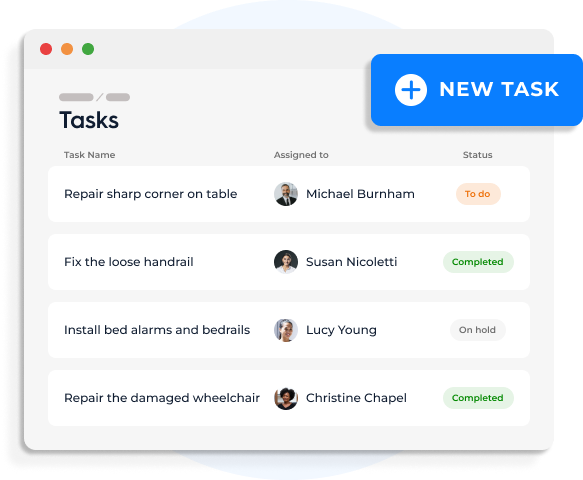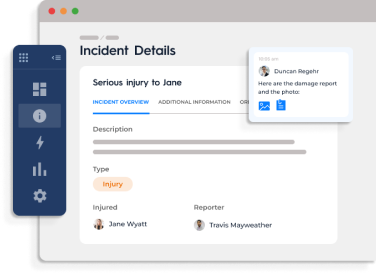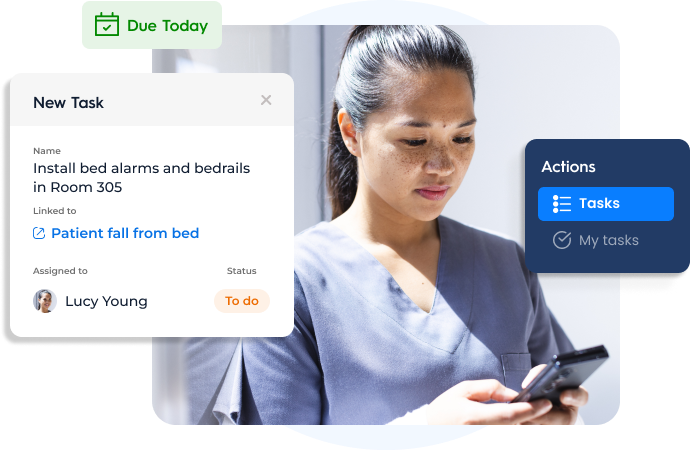When an incident occurs, how do we ensure it doesn’t happen again?
Effective incident reporting in healthcare is essential for documenting, analysing, and learning from incidents. This allows for quick identification and resolution of safety breaches, helping to prevent future incidents.
As the healthcare sector evolves, the use of incident reporting software has become increasingly significant.
These digital tools offer multiple benefits in healthcare, each contributing to the overarching objective of improved patient safety, care quality, and regulatory compliance. Let’s delve into these benefits and understand how they collectively work towards enhancing the safety culture in healthcare organisations.

1. Enhanced Accuracy and Detail in Reporting
One of the standout benefits of a digital system for reporting incidents is the precision and comprehensiveness it brings to incident documentation.
Incident reporting software captures a wide array of data points that may be overlooked in manual methods, such as exact times, locations, involved individuals, and event sequences. This level of data is crucial for full understanding.
Additionally, traditional hand written incident reports often feature illegible handwriting, posing challenges for supervising staff during the review process. This issue is effectively eliminated with digital reporting.
Digital systems also offer the capability to upload files, photos, and videos to incident reports, providing more detail for a clearer and more complete picture of each incident.
This wealth of information is essential for effective incident analysis. It helps healthcare professionals spot patterns and underlying causes of incidents, leading to better corrective and preventive actions and improving patient safety and care quality.
2. Improved Compliance with Regulatory Standards
In the landscape of healthcare, following regulatory standards is essential not just for legal reasons but also for ensuring high-quality patient care. The Care Quality Commission (CQC) in the UK sets key standards for reporting healthcare incidents.
Modern digital incident reporting solutions can automate and streamline the reporting process, ensuring that reports are completed accurately and efficiently. This is critical for maintaining compliance with industry regulations.
Incident reporting software is designed to be updated in line with regulatory changes, keeping healthcare providers compliant with the latest standards. This feature is particularly significant, as healthcare regulations can frequently evolve.
Automated updates relieve healthcare staff from the burden of constantly monitoring these changes, allowing them to focus on patient care while maintaining compliance effortlessly.
3. Faster Incident Response and Resolution
Another significant benefit of digital incident reporting is real-time reporting.
Incident reporting software can send immediate alerts and notifications to relevant staff upon submission of an incident report. This ensures swift awareness of critical incidents, enabling a prompt response.
This real-time notification capability speeds up incident resolution by streamlining the follow-up process. It also enhances the ability of healthcare providers to quickly address and manage potential risks and prevent future incidents, thereby improving patient safety and quality of care.
Such rapid response is crucial in healthcare environments where every second counts.
4. Data Analytics and Trend Analysis
Incident reporting software greatly enhances data analytics and trend analysis in healthcare. This is vital for identifying clinical risks and contributing factors involved in adverse events.
Unlike traditional paper reporting, digital platforms allow for incident data to be collated and analysed to identify trends and make proactive improvements.
Such a vast repository of data allows for thorough insights into the root causes of incidents, facilitating a deeper understanding of how they occur.
A study from three Swedish hospitals underscores this benefit, revealing that digital incident reporting systems provided valuable insights into identifying problem areas.
This analysis is crucial for pinpointing areas needing improvement. It helps healthcare providers proactively address risks and refine practices and policies, thus improving patient safety and overall care standards.

5. Increased Reporting Rates
It has been observed that user-friendly digital platforms stimulate more regular reporting.
Mobile apps are especially effective in boosting reporting rates in healthcare environments.
These apps offer speed and ease of access, enabling healthcare workers to quickly report incidents on the go using their mobile devices. This convenient approach overcomes the hurdles of traditional reporting methods, which are often more time-consuming and less accessible.
Furthermore, digital incident reporting integrates seamlessly into daily workflows, enhancing transparency and fostering a culture of safety in the workplace. This transparent environment encourages healthcare staff to report incidents more frequently.
This surge in reporting provides healthcare organisations with a more comprehensive understanding of incident patterns, contributing to more effective clinical risk management and enhanced patient safety.
6. Enhanced Communication and Collaboration

Digital systems are instrumental in enhancing teamwork and communication among healthcare teams.
An effective incident reporting software serves as a centralised hub for incident information, with real-time access and analytics that contribute to trend tracking and learning. This fosters a safer patient care environment and ensures all relevant staff are informed and can collaborate more effectively on response strategies.
Furthermore, the use of resolved patient incident reports as case studies or training materials turns past incidents into valuable learning opportunities. This practice prepares healthcare workers for real-life situations and promotes learning from past mistakes, continuously improving the standard of care provided.
7. Customisable Reporting Templates
The successful implementation of an incident reporting system goes beyond merely integrating a system into existing processes. It involves aligning the system with the organisation’s safety culture and procedures.
Many digital incident reporting platforms offer customisable reporting templates tailored to the specific needs of different healthcare scenarios. This ensures the most relevant and essential information is captured efficiently.
The flexibility of these forms means healthcare workers can report incidents more efficiently and collect incident data of higher quality. This is crucial for informed decision-making and safety improvements.
By ensuring that only pertinent information is collected, these customisable templates streamline the reporting process, making it less laborious and more accurate.
8. Easy Assignment and Monitoring of Follow-Up Actions

A key aspect of incident management involves identifying issues, assigning required corrective actions, and ensuring their completion.
Manual incident reporting processes involve managing spreadsheets, paperwork, and communication across various platforms, all of which can impede quality care or delay corrective actions. Other than being time-consuming, these manual processes are prone to miscommunication and errors, resulting in critical aspects being overlooked.
Recent advancements in incident reporting software often enable the immediate assignment of corrective actions to specific individuals or teams, creating a clear line of responsibility and accountability.
Once actions are assigned, their progress and status can be tracked in real-time, preventing any oversight. This is a major benefit over traditional paper methods, where tracking the status of corrective actions and follow-up needs is often challenging.
This is particularly valuable in a fast-paced healthcare environment where quick actions can significantly improve patient safety and care quality. The ability to monitor the progress of corrective actions ensures that measures are not only proposed but also implemented effectively and within a reasonable timeframe.
Furthermore, this tracking capability provides an ongoing overview of the incident management process, helping to identify any bottlenecks or delays. It facilitates continuous quality improvement by highlighting areas where processes can be optimised or where additional training might be required.
9. Improving Brand Reputation

Aside from boosting care quality and compliance, efficient incident management also has a significant yet often-overlooked impact on an organisation’s reputation.
Healthcare organisations that demonstrate a strong track record in handling incidents swiftly are seen as more trustworthy and credible.
This enhanced reputation for safety and responsiveness builds confidence among patients and their families, along with staff and the wider healthcare community. In an industry where trust is paramount, showing dedication to patient safety and quality care can set an organisation apart, attracting more patients and top-tier healthcare professionals.
The CQC sets strict quality and safety standards for healthcare, providing public access to inspection reports. Beyond immediate consequences, failing to meet these standards has a long-term impact on patient trust and institutional reputation. Therefore, leveraging reliable digital solutions to ensure compliance can directly bolster an organisation’s public image.
Moreover, a strong reputation can also lead to broader benefits such as increased patient satisfaction, higher staff morale, and potentially better funding opportunities.
In essence, prioritising effective incident management through digital systems not only improves healthcare operations but also significantly boosts the organisation’s overall image and perception in the eyes of all stakeholders.
The Role of Technology in Streamlining Healthcare Incident Reporting

Beyond the benefits we have explored, using technology in healthcare incident reporting adds a crucial layer of structure to the process.
This structured approach is crucial for consistency, accuracy, and efficiency in reporting, which are fundamental in a healthcare environment where every detail matters.
A well-structured system not only aids in the immediate management of incidents but also contributes to long-term strategies for risk reduction, helping to improve patient safety and care.
Our incident reporting platform streamlines the incident reporting process in healthcare with the following key features:
Real-time reporting via web, mobile app, or QR code scanning for immediate incident logging.
Immediate notifications sent to relevant staff upon submission of a report, enabling quicker response times to incidents.
Easy assignment and monitoring of corrective actions and deadlines through web or mobile app.
Customisable incident report templates to capture all necessary information accurately.
Comprehensive analytics dashboards for insights into key incident metrics, tailored to your needs.
A centralised data repository for all incident data, from photos to statements, in one accessible location.

Summary
In the dynamic and complex healthcare landscape, where the core objectives remain to guarantee quality care, compliance, and the protection of patient safety, incident reporting software serves as an essential tool. It offers critical insights into incidents, their root causes, and strategies for prevention.
Switching to a digital reporting system frees healthcare staff from the slow and cumbersome manual reporting process. This lets them focus on what’s most important — providing patients with safe, effective, compassionate, and responsive quality care.
To learn more about how our incident reporting platform can benefit your healthcare organisation, talk to our sales team here.

